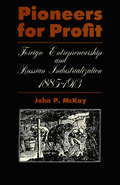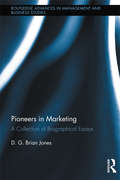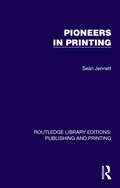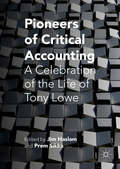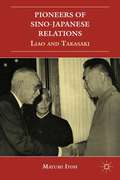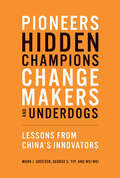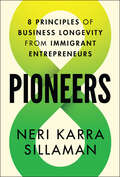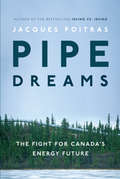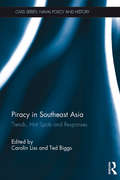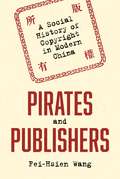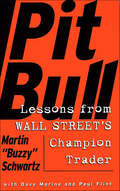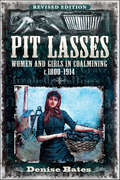- Table View
- List View
Pioneers for Profit: Foreign Entrepreneurship and Russian Industrialization, 1885-1913
by John P. McKayForeign investment increased from 17 percent of the capital of industrial corporations in Imperial Russia in 1880 to 47 percent in 1914, coinciding with the rapid development of Russian industrialization before World War I. John McKay's study, based largely on intensive research in numerous archives and utilizing many previously unexplored private business records, is the first detailed analysis of the impact of foreign enterprise on Russian industry during this period. His conclusions are significant for historians, economists, and those interested in the development of modern industrial society.
Pioneers in Marketing: A Collection of Biographical Essays (Routledge Advances in Management and Business Studies)
by D.G. Brian JonesPioneers in Marketing: A Collection of Biographical Essays discusses eight historically important marketing scholars whose careers collectively spanned over 100 years. An introductory chapter describes the role of biography in the study of marketing thought, and introduces the eight subjects in this collection. Subsequent chapters describe the lives of Edward David Jones, Simon Litman, Henry Charles Taylor, Percival White, George Burton Hotchkiss, Theodore N. Beckman, David D. Monieson, and William R. Davidson, focusing on their intellectual and professional contributions to the marketing discipline. The biographies are based on rare archival materials, some personal interviews, and analysis of the subjects’ major works. The final chapter draws lessons from the collection for marketing students and teachers. Several important discoveries are reported that suggest opportunities for further research. These stories will inform and inspire students of marketing.
Pioneers in Printing (Routledge Library Editions: Publishing and Printing)
by Seán JennettOriginally published in 1958, through a series of lively biographies of men important in the history of printing – Gutenberg, Caxton, Baskerville, Caslon, Senefelder, Koenig, Mergenthaler, and Lanston – Pioneers in Printing traces the growth and development of the craft of printing from its invention in the fifteenth century to modern times. The aim of the book is not to recount the technicalities of machinery, but rather to present each character as a living man engrossed in his ideas and pursuing them persistently, in conflict or in agreement with his period. The book is written in a clear and easy style, free of technical terms.
Pioneers of Capitalism: The Netherlands 1000–1800 (The Princeton Economic History of the Western World #132)
by Maarten Prak Jan Luiten van ZandenHow medieval Dutch society laid the foundations for modern capitalismThe Netherlands was one of the pioneers of capitalism in the Middle Ages, giving rise to the spectacular Dutch Golden Age while ushering in an era of unprecedented, long-term economic growth. Pioneers of Capitalism examines the formal and informal institutions in the Netherlands that made this economic miracle possible, providing a groundbreaking new history of the emergence and early development of capitalism.Drawing on the latest quantitative theories in economic research, Maarten Prak and Jan Luiten van Zanden show how Dutch cities, corporations, guilds, commons, and other private and semipublic organizations provided safeguards for market transactions in the state&’s absence. Informal institutions developed in the Netherlands long before the state created public safeguards for economic activity. Prak and van Zanden argue that, in the Netherlands itself, capitalism emerged within a robust civil society that constrained and counterbalanced its centrifugal forces, but that an unrestrained capitalism ruled in the overseas territories. Rather than collapsing under unrestricted greed, the Dutch economy flourished, but prosperity at home came at the price of slavery and other dire consequences for people outside Europe.Pioneers of Capitalism offers a panoramic account of the early history of capitalism, revealing how a small region of medieval Europe transformed itself into a powerhouse of sustained economic growth, and changed the world in the process.
Pioneers of Critical Accounting
by Jim Haslam Prem SikkaThis book celebrates the life and work of Tony Lowe, a pioneer ofcritical accounting. The authors elaborate on the fact that Tony Lowe regardedaccounting as a moral and political practice rather than some dry technicalphenomena because it has serious social consequences. The essays in the bookare written by a global community of Tony's former colleagues and students andshow the value of adopting interdisciplinary perspectives. The essays locateaccounting and business practices in wider social, economic and politicalcontexts to show that Tony's ideas had far reaching applications forregulation, corporation governance, accounting, auditing, the environment,corporate social responsibility, organisational accountability, gender, race,globalization and the functioning of the state. The book is suitable forundergraduate and postgraduate students, scholars and practitioners seeking tofree themselves from the shackles of conventional views about accounting andbusiness practices.
Pioneers of European Integration and Peace 1945-1963: A Brief History with Documents
by Sherrill Brown WellsThis book explores the political risks taken by those farsighted leaders in the postwar period to heal the wounds of hostility and prevent another war.
Pioneers of Sino-Japanese Relations
by Mayumi ItohThis book examines the careers of Liao Chengzhi and Takasaki Tatsunosuke, who were not only the architects of Sino-Japanese economic relations, but also pioneers of contemporary Sino-Japanese relations. Their visions and initiatives offer many insights into the current contentious relations among China, Japan, Russia, and the United States.
Pioneers of a Profession: Chartered Accountants to 1879 (Routledge Library Editions: Accounting History #34)
by Jas. C. StewartThis book, first published in 1986, analyses the lives and careers of the founding members of the Institute of Chartered Accountants of Scotland. Contemporary professional accountancy owes its formal beginnings to the nineteenth-century Scottish accountants who formed the first professional bodies, and this book provides valuable insights for the accounting historian on the backgrounds, education, work styles and integrity of those early accountants.
Pioneers, Hidden Champions, Changemakers, and Underdogs: Lessons from China's Innovators (The\mit Press Ser.)
by George S. Yip Wei Wei Mark J. GreevenAn insider's view of China's under-the-radar, globally competitive innovators.Chinese innovators are making their mark globally. Not only do such giants as Alibaba and Huawei continue to thrive and grow through innovation, thousands of younger Chinese entrepreneurs are poised to enter the global marketplace. In this book, Mark Greeven, George Yip, and Wei Wei offer an insider's view of China's under-the-radar, globally competitive innovators. The authors, all experts on Chinese innovation, distinguish four types of innovators in China: pioneers, large companies that are globally known; hidden champions, midsize enterprises that are market leaders in their niches; underdogs, technology-driven ventures with significant intellectual property; and changemakers, newer firms characterized by digital disruption, exponential growth, and cross-industry innovations. They investigate what kinds of innovations these companies develop (product, process, or business model), their competitive strategies, and key drivers of innovation. They identify six typical ways Chinese entrepreneurs innovate, including swarm innovation (collectively pursuing opportunities) and rapid centralized decision making. Finally, they look at how Chinese innovators are going global, whether building R&D networks internationally or exporting disruptive business models. The book includes many examples of Chinese innovators and innovations, drawn from a range of companies—from pioneers to changemakers—including Alibaba, Haier, Hikvision, Malong Technology, Weihua Solar, Mobike, and Cheetah Mobile. Greeven, Yip, and Wei offer an essential guide to what makes China a heavyweight competitor in the global marketplace.
Pioneers: 8 Principles of Business Longevity from Immigrant Entrepreneurs
by Neri Karra SillamanUnlock the principles that drive the remarkable success stories of immigrant entrepreneurs from around the world In Pioneers: 8 Principles of Business Longevity From Immigrant Entrepreneurs, academic, entrepreneur, and consultant, Neri Karra Sillaman, delivers a one-of-a-kind exploration of the remarkable success of immigrant entrepreneurs. The author writes about how immigrants, often starting with limited capital and connections, have built iconic and enduring businesses. Sillaman combines rigorous academic research with compelling case studies and personal experience and narrative to uncover the principles that drive these stunning achievements. Pioneers offers a blueprint for business leaders seeking longevity, profitability, and sustainability in the contemporary marketplace. You'll find: Strategies for building resilient businesses that embrace diversity and inclusion Explanations of the power of community and how you can leverage it for business growth Stories of the importance of creating a legacy that goes beyond mere profit Techniques and actionable advice to turn past failures into future success Exploring the dramatic immigrant success stories powering such well-known brands as Chobani, WhatsApp, and BioNTech, this book is a must-read for entrepreneurs, business leaders, and anyone else interested in the dynamics of immigrant entrepreneurship. Pioneers is a transformative and inspiring business guide that will help you build a company that stands the test of time.
Pipe Dreams: The Fight for Canada's Energy Future
by Jacques PoitrasA timely chronicle of how Canada's oil pipelines have become hotbeds for debate about our energy future, Indigenous rights, environmental activism, and east-west political tensions. Pipe Dreams is the dramatic story of the rise and fall of the Energy East pipeline and the broader battle over climate and energy in Canada. The project was to be a monumental undertaking, beginning near Edmonton, AB, and stretching over four thousand kilometres, through Montreal to the Irving Oil refinery in Saint John, NB. Conceived as a back-up plan for the stalled Keystone XL pipeline, it became the crucible for a national debate over the future of oil. In a cross-country journey, Poitras talked to industry executives, prairie ranchers, First Nations chiefs, mayors, premiers, cabinet ministers, and refinery workers. He also explored Canada's perplexing oil relationship with the United States: our industry is literally tied to its American counterpart with sinews of steel. The Energy East pipeline represented a new direction, designed to get Alberta oil sands crude to lucrative world markets. Yet it was promoted in explicitly nationalist terms: the country was said to be reorienting itself along its east-west axis, tying itself together, again, with a great feat of engineering. By the time the journey ended, the story had become a kind of whodunit: Poitras witnessed the slow-motion killing of the fifteen billion dollar project. Unfolding in tandem with clashes over the Trans Mountain pipeline, Energy East's demise heralded a potential turning point not just for a single proposal, but for Canada's carbon economy.Entertaining, informative, and insightful, Pipe Dreams offers a clear picture of the complicated political, environmental, and economic issues that Canadians face.
Pipeline Pedagogy: Teaching About Energy and Environmental Justice Contestations (AESS Interdisciplinary Environmental Studies and Sciences Series)
by Valerie Banschbach Jessica L. RichThe proliferation of pipelines to transport oil and natural gas represents a major area of contestation in the landscape of energy development. Battles over energy pipelines pit private landowners, local community representatives, and environmentalists against energy corporations and industry supporters, sometimes drawing opposition and attention from well beyond the impacted regions, as in the case of the Standing Rock/Dakota Access Pipeline. Stakeholders must navigate complex government regulatory processes, interpret technical and scientific reports, and endure lengthy and expensive court battles. As with other forms of environmental injustice, the contentious construction of pipelines often disproportionately impacts communities of lower economic development, people of color, and indigenous peoples; pipelines also pose potential short and long-term health and safety threats. With the expansion of energy pipelines carrying fracked oil and gas across the United States and abroad, the moment is ripe for teaching about pipeline projects and engaging students and community members in learning about methods for mobilization. Our volume examines pedagogical opportunities, challenges, and interventions that campus-community engagement, and other kinds of community engagement, produce in relation to infrastructuring in the form of pipeline development.
Piracy in Somalia (A)
by Sophus A Reinert Alissa Davies"As dawn broke over the Indian Ocean on 17 February, 2011, a young Somali fisherman stood on a beach near his home in Garacad, a fishing village in the Mudug region of the North-Eastern semi-autonomous state of Puntland, itself part of the shifting patchwork of overlapping administrations, clans, and fiefdoms often referred to as Somalia, “the world’s most dangerous place.”1 A periodic drought had resulted in an ongoing famine that had cost hundreds of thousands of Somalis their lives, and his stomach grumbled. Gazing out to sea, he faced an agonizing choice. To his right, his small wooden fishing vessel, loaded with rudimentary nets and meager provisions, lay on the beach, ready to set sail. On his left, great commotion surrounded two rusty speedboats that were being loaded with food, petrol, AK-47s, and ammunition, equipment needed to hunt a different sort of prey. Two dozen young men were busily transporting supplies from Land Rovers parked on the nearby dunes, communicating by satellite phones with a larger “mother ship” moored within view off the coast. They were local pirates, and their beach buzzed with news of several large sailing ships heading towards the Gulf of Aden from the Indian Ocean."
Piracy in Southeast Asia: Trends, Hot Spots and Responses (Cass Series: Naval Policy and History)
by Carolin Liss Ted BiggsThis book combines multi-disciplinary ethnographic and theoretical approaches to examine piracy in Southeast Asia and the regional and international responses to this threat. During the piracy boom of the early to mid-2000s, the issue of piracy in Southeast Asia received substantial academic attention. Recent scholarship, however, has shifted the focus to Somali piracy and the resurgence of piracy in Southeast Asia has largely been neglected in the academic community. This volume seeks to remedy this gap in the current literature. The primary aim is to examine how piracy has evolved in Southeast Asia over the past ten years, to address why piracy has re-emerged as a security threat, to evaluate efforts at maintaining security in regional waters, and to offer an analysis of what might be expected in the next decade. The contributions are drawn from academics, policy makers, and military officers, covering a range of disciplines including international relations, socio-cultural anthropology, security studies, history, law, and Asian studies. Taken together, the contributions in this volume provide a better understanding of contemporary piracy in Southeast Asia and suggest avenues to successfully combat piracy in this region. This book will be of much interest to students of maritime security, Asian politics, security studies, and international relations in general.
Piramal Foundation: The Business of Philanthropy
by Vikram Gandhi Mahima Rao-KachrooThe Piramal Foundation was launched by diversfied Indian conglomerate, the Piramal Group, to improve the healthcare services and quality of education of India's economically and socially disadvantaged. The foundation operates under three verticals-'Piramal Foundation for Education Leadership' (PFEL) for improvements in student learning outcomes; 'Swasthya' for healthcare; and 'Sarvajal' for safe drinking water. Over the years, the Foundation has directly and indirectly benefitted nearly 90 million lives, yet its management team find themselves in a quandary. With finite resources, mostly provided by the Piramal Group, they wonder if they ought to only grow existing programs that show the most promise. They also wonder how to attract more external funding and how to further embed their programs into government platforms in order to create impact at scale.
Piramal e-Swasthya (A): Attempting Big Changes for Small Places - in India and Beyond
by Rosabeth Moss Kanter Matthew BirdAnand Piramal and his team sought to "democratize healthcare" in India through the development of a new service delivery model. If Henry Ford could build and deliver cars to everyone in the United States, Piramal thought, then why can't India deliver healthcare to the 70% of its citizens who lack access to it? They began pilots in 2008 but soon ran into unexpected difficulties. After a second round of pilots in early 2010, they had to decide whether to proceed and if so how.
Piramal e-Swasthya (B): Considering Change
by Rosabeth Moss Kanter Joyce J. KimFrom 2008-2010 Anand Piramal ran a series of pilots for his digital healthcare startup, Piramal e-Swasthya (PeS) to "democratize healthcare" in rural areas of India. PeS ran into difficulties so Anand Piramal had to decide whether to continue the organization and if so how. In 2010, an unexpected opportunity emerged that could have significant implications for PeS's organizational structure and future prospects. Anand Piramal now faced several options for PeS. He needed to weigh the pros and cons of each option to make the best decision to fulfill his vision of providing quality healthcare services to "bottom-of-the-pyramid" populations. This case exemplifies the strategic decisions an entrepreneur must make to ensure that a social impact venture can be sustainable and scalable.
Piramal e-Swasthya (C): A New Name, Bigger Scope, and Public-Private Partnerships
by Rosabeth Moss Kanter Joyce J. KimIn 2010, Anand Piramal acquired the Health Management Research Institute (HMRI), a healthcare venture, and merged it with his original digital healthcare startup Piramal e-Swasthya (PeS), so that PeS became Piramal Swasthya. After acquiring HMRI, Piramal Swasthya scaled across 20 Indian states and became India's largest private primary healthcare initiative by implementing public-private partnerships with state governments. In 2012, Anand Piramal stepped down as CEO of Piramal Swasthya, leading to organizational change and a healthcare strategy focused on improving maternal health amongst India's most vulnerable populations. This case shows how an organization can achieve innovation at scale through cross-sector collaboration.
Pirates and Publishers: A Social History of Copyright in Modern China (Studies of the Weatherhead East Asian Institute #6)
by Fei-Hsien WangA detailed historical look at how copyright was negotiated and protected by authors, publishers, and the state in late imperial and modern ChinaIn Pirates and Publishers, Fei-Hsien Wang reveals the unknown social and cultural history of copyright in China from the 1890s through the 1950s, a time of profound sociopolitical changes. Wang draws on a vast range of previously underutilized archival sources to show how copyright was received, appropriated, and practiced in China, within and beyond the legal institutions of the state. Contrary to common belief, copyright was not a problematic doctrine simply imposed on China by foreign powers with little regard for Chinese cultural and social traditions. Shifting the focus from the state legislation of copyright to the daily, on-the-ground negotiations among Chinese authors, publishers, and state agents, Wang presents a more dynamic, nuanced picture of the encounter between Chinese and foreign ideas and customs.Developing multiple ways for articulating their understanding of copyright, Chinese authors, booksellers, and publishers played a crucial role in its growth and eventual institutionalization in China. These individuals enforced what they viewed as copyright to justify their profit, protect their books, and crack down on piracy in a changing knowledge economy. As China transitioned from a late imperial system to a modern state, booksellers and publishers created and maintained their own economic rules and regulations when faced with the absence of an effective legal framework.Exploring how copyright was transplanted, adopted, and practiced, Pirates and Publishers demonstrates the pivotal roles of those who produce and circulate knowledge.
Pissing on Demand: Workplace Drug Testing and the Rise of the Detox Industry (Alternative Criminology #18)
by Ken D. TunnellDrug testing has become the norm in many workplaces. In order to get a job, potential employees are required to provide their urine for testing. Pissing on Demand examines this phenomenon along with the resulting rise of the anti-drug testing movement, or the "detox industry," that works to beat these tests. Strategies include over-the-counter products like "body flushers" that sound innocent but are really designed to mask the presence of illegal drugs to kits advertised in pro-drug publications like High Times that make no bones about their real purpose. The first exposé of the detox industry in all its manifestations, this book is required reading for anyone concerned with social control, privacy, and workers' rights.
Pistols and Petticoats: 175 Years of Lady Detectives in Fact and Fiction
by Erika JanikA lively exploration of the struggles faced by women in law enforcement and mystery fiction for the past 175 yearsIn 1910, Alice Wells took the oath to join the all-male Los Angeles Police Department. She wore no uniform, carried no weapon, and kept her badge stuffed in her pocketbook. She wasn't the first or only policewoman, but she became the movement's most visible voice.Police work from its very beginning was considered a male domain, far too dangerous and rough for a respectable woman to even contemplate doing, much less take on as a profession. A policewoman worked outside the home, walking dangerous city streets late at night to confront burglars, drunks, scam artists, and prostitutes. To solve crimes, she observed, collected evidence, and used reason and logic--traits typically associated with men. And most controversially of all, she had a purpose separate from her husband, children, and home. Women who donned the badge faced harassment and discrimination. It would take more than seventy years for women to enter the force as full-fledged officers.Yet within the covers of popular fiction, women not only wrote mysteries but also created female characters that handily solved crimes. Smart, independent, and courageous, these nineteenth- and early twentieth-century female sleuths (including a healthy number created by male writers) set the stage for Agatha Christie's Miss Marple, Sara Paretsky's V. I. Warshawski, Patricia Cornwell's Kay Scarpetta, and Sue Grafton's Kinsey Millhone, as well as TV detectives such as Prime Suspect's Jane Tennison and Law and Order's Olivia Benson. The authors were not amateurs dabbling in detection but professional writers who helped define the genre and competed with men, often to greater success.Pistols and Petticoats tells the story of women's very early place in crime fiction and their public crusade to transform policing. Whether real or fictional, investigating women were nearly always at odds with society. Most women refused to let that stop them, paving the way to a modern professional life for women on the force and in popular culture.
Pit Bull: Lessons from Wall Street's Champion Trader
by Amy Hempel Martin Schwartz Dave Morine Paul Flint“Investors who feel like they have what it takes to trade . . . should read Pit Bull.” —The Wall Street JournalWelcome to the world of Martin “Buzzy” Schwartz, Champion Trader—the man whose nerves of steel and killer instinct in the canyons of Wall Street earned him the well-deserved name “Pit Bull.” This is the true story of how Schwartz became the best of the best, of the people and places he discovered along the way, and of the trader’s tricks and techniques he used to make his millions.“The most entertaining and insightful look at Wall Street since Liar’s Poker.” —Paul Tudor Jones II, founder, Tudor Investment Corporation and the Robin Hood Foundation“An archetypal text, true to life on the Street, destined to be discussed over drinks at trader hangouts after the market closes.” —Kirkus Reviews“Hilarious and eye-opening . . . Pit Bull tells the real deal about life on Wall Street—and how you make money there.” —Martin Zweig, author of Martin Zweig’s Winning on Wall Street
Pit Lasses: Women and Girls in Coalmining c.1800–1914
by Denise BatesWomen have long been recognized as the backbone of coalmining communities, supporting their men. Less well known is the role which they played as the industry developed, working underground alongside their husband or father, moving the coal which he had cut. The year 2012 is significant as it is the 170th anniversary of the publication of the Report of the Commission into the Employment of Children and Young People in Coal Mines (May 1842). The report findings included the revelation that in some mines half-dressed women worked alongside naked men. The resulting outrage led to the banning of females working underground three months later. The Report of the Commission has been neglected as a source for many decades with the same few quotations regularly being used to illustrate the same headline points. And yet about 500 women and girls gave statements about what mining was like in 1841 and in earlier years in different parts of the country. In conjunction with the 1841 census it paints a comprehensive, though previously unexplored picture of the work of a female miner, how she lived when not at work, how she was regarded by the wider community and what she could achieve. Although banned from working underground, women were still allowed to work above ground after 1842. In the second half of the nineteenth century around 3,000 women continued to be employed at the pit head though this was increasingly confined to the pit brow lasses of Lancashire. This book examines the life of the female miner in the nineteenth century through to the outbreak of the Great War, both at work and away from it, drawing out the largely untapped evidence within contemporary sources - and challenging received wisdoms.
Pitch Craft: The Writer's Guide to Getting Agented, Published, and Paid
by Laura GoodeAn award-winning author and Stanford writing instructor demystifies the business of writing with this practical, procedural guide to creating successful pitches, impressing editors and agents, negotiating compensation, and more.Published multi-genre writer Laura Goode had an epiphany after finishing her MFA and building a freelancing career: Nobody is teaching writers how to wield their persuasive storytelling abilities to make money from their writing. So she decided to write the business-of-writing handbook she needed most.Pitch Craft draws on Goode&’s experience as a novelist, poet, essayist, filmmaker, and creator of a pitching and publishing course to uncover what nobody else will tell you about the business strategy that creates a writing career. With unapologetic honesty earned from years of navigating the publishing world, each chapter in this valuable insider's guide close-reads a distinct element of putting your work out into the world, such as:• Constructing effective author bios and websites• Leveraging your social media platform• Developing a reliable template for pitches and queries• Cultivating relationships with publishing gatekeepers • Strengthening your self-advocacy skillsPitch Craft is for writers in all genres and of all experience levels, whether you're just getting started, are considering applying to a graduate program, or have been in the trenches for decades. After reading and completing the assignments in Pitch Craft, you'll hold a finished pitch in hand and the knowledge and skills to navigate your dream literary career.
Pitch Invasion: My story as a feminist on a Football Club board
by Karen DobresKaren Dobres never expected to fall for football - let alone help revolutionise it. In Pitch Invasion, Karen shares her hilarious and heartfelt journey from someone who 'always zoned out when bloody football was on the telly' to becoming a Director at Lewes FC - the first football club in the world to pay its women and men players equally.In 1994, Karen could barely sit through a match at Wembley. Fast forward to 2023, and she's introducing multi-million-pound deals for the women's team of her local club. How does a trained counsellor and former catwalk model end up navigating the male-dominated world of football? And how did she turn her 'imposter syndrome' into a tool for change?With bisexual pirates, vegan snacks, and even a designated breastfeeding area, Lewes FC is no ordinary football club. It's a pioneering force for equity, inclusion, and innovation. Through Karen's witty, self-deprecating storytelling, Pitch Invasion gives readers an insider's view of the quirky yet revolutionary culture at Lewes FC. From organising Suffragette flash mobs to introducing Prosecco on tap at the stadium, Karen brings to life her experiences at this fan-owned, debt-free, gender-equal club where everyone - from local supporters to pop stars - helps shape the future of the game.From 2017, when women's football was still fighting for recognition, to the present day, Pitch Invasion is the story of how one woman helped lead the charge for gender equality, challenging football's entrenched hegemony, not just for one club, but across the UK.
